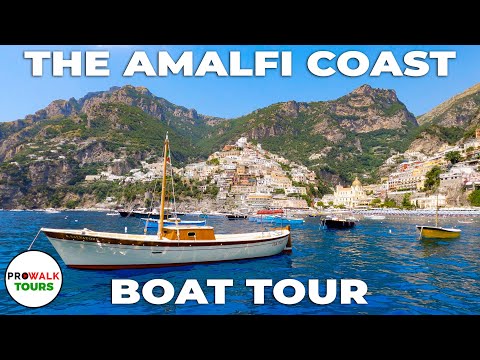Amalfi Coast, Italy Boat Tour - Incredible Moving Art!

We begin our tour just west of the town of Positano, at the Grotta delle Soppressate or del Mezzogiorno, a cave that is inaccessible without rock climbing equipment. We are heading east along the Amalfi Coast, a stretch of coastline renowned for its beauty in the Campania region of Italy on the Tyrrhenian sea. The Amalfi Coast is characterized by its vertical landscape, with rugged cliffs and towns interwoven with steep flights of stairs. The steep coastline may seem inhospitable, but inhabitants have cultivated and tamed the landscape for centuries in order to build towns and create arable land for agriculture.
Torre Clavel was originally a watchtower built in the early 13th century as part of the defense system against invasions. At the beginning of the 20th century, Futurist writer Gilbert Clavel fell in love with the beauty of the tower’s location and transformed the building into a residence. It is now possible to rent the property, which is spread over several levels and connected with various passageways and corridors.
Fornillo Beach is a picturesque walk away from the center of Positano, and is generally more peaceful than the beaches closer to the town center. Torre Trasita is another watchtower, this time dating from the 16th century, which has been restored and is let out as tourist accommodation. The village of Positano is one of the most popular along the Amalfi Coast for its pretty cascade of pastel-colored houses. Despite prospering as a port between the 15th and 17th centuries, it lost much of its population during the 19th century.
One of Positano’s most famous attractions is the Church of Santa Maria Assunta which houses a 13th-century icon of a black Madonna. Positano was transformed from a poor fishing village to a tourist hotspot partly thanks to John Steinbeck’s 1953 essay about Positano in Harper's Bazaar. The Amalfi Coast’s coastal landscape is a series of bays, grottoes, inlets, fjords, pebbled beaches, and rock formations. Arienzo Beach Club is one of many small beaches usually only accessible either by a long flight of stairs or by boat. This beach club, like most, runs a shuttle service from Positano.
The towns of the Amalfi Coast are connected by a road running down the coastline built in the 19th century. The coastal road is known for its stunning panoramas, but also for its serpentine twists and turns that can be quite nerve-wracking for the unfamiliar driver. Before the coastal road was built, inhabitants moved between towns using footpaths and mule tracks.
The stairways, footpaths and mule tracks are still used to reach many houses not immediately accessible by road, as well as by hikers. Da Adolfo is a typical trattoria that offers a shuttle service from Positano easily recognizable by the red fish atop the boat. The Sentiero degli Dei is one of the most popular hiking routes along the Amalfi Coast and runs along this stretch from Bomerano to Nocelle, with a flight of around 1700 steps to reach Positano. The Sentiero degli Dei translates as the Path of the Gods and is so named because it was believed that the gods used this trail to descend to the sea and rescue Homer’s Ulysses from the seductive calls of the sirens. The spectacular views from the Path of the Gods are renowned, but the trail isn’t advised for those who suffer vertigo. You can click on the link above to watch a walking tour of the Path of the Gods.
Here you can see one of the staircases that zigzags down from a cliff-top villa to the sea. Once, these were the only way to get around the coastline. The flight of steps belongs to Grand Hotel Tritone, a four-star hotel, and leads to a private beach. There is now also a lift to save guests having to make the exhausting climb up and down the stairs. La Gavitella is a beach-side restaurant with views all the way down the coastline and out to famous islands like Li Galli. The seaside eatery is accessible by stairs from the nearby town of Praiano or by a shuttle service. Torre di Grado was built in 1564 using remains from a medieval tower.
These towers were positioned on promontories so that each could signal to one another when a Saracen pirate invasion was imminent. Gabriel is a great guide with two different boats avaiable for tours along the coast. This is his smaller boat. The Amalfi Coast was once part of the Roman Empire and was dotted with Roman villas, remains of which can be seen in the town of Minori and on the island of Capri. The town of Praiano, whose name derives from the word ‘praia’ meaning beach, is home to the 12th-century church of San Luca Evangelista and the 12th-13th century church of San Giovanni Battista with a colorful maiolica tile floor.
This 13th-century watchtower, Torre a Mare or Torre Asciola, has been transformed into a magical artist’s studio. Praiano was once used as a summer residence for doges (heads of state) of the Duchy of Amalfi, an independent republic centered in the town of Amalfi during the 10th and 11th centuries. In 1997, the Amalfi Coast was designated as a UNESCO World Heritage Site thanks to its “great physical beauty and natural diversity”, the architecture of towns like Amalfi and Ravello, and the diverse agricultural cultivation of the land. The hamlet of Fiordo di Furore is a handful of houses set around a spectacular fjord. Its unique geography means both fishing and farming are key economies in the tiny settlement. It is designated as one of the most beautiful villages in Italy.
In July, a diving competition off the bridge is held for professionals. Thanks to the Duchy of Amalfi’s prestige as a maritime republic, the Amalfi Coast prospered through trade with other Mediterranean seaports. In this inlet, you can find the Grotta dello Smeraldo, so named for the emerald color that fills the interior thanks to an underwater opening letting in sunlight. This promontory of rock is called the Capo di Conca and above lies the village of Conca dei Marini. The name derives from the word ‘conca’ meaning bowl or basin. This fortified watchtower was built in the 16th century as part of the defenses against pirate raids. After the threat of invasion faded with the defeat of the Turks at the Battle of Lepanto, the tower was used as a cemetery until 1949. The Duchy of Amalfi prospered by trading grain, salt, slaves and timber for gold currency from Egypt and Syria then used to buy Byzantine silks to be sold in Europe.
Sophia Loren starred in films set on the Amalfi Coast like Scandal in Sorrento and is an honorary citizen of Sorrento. There are about 30 watchtowers dotted along the coastline that were part of the defense system. Since the late 19th century, the rich and famous have been flocking to the Amalfi Coast. Artist John Singer Sargent and writer Somerset Maugham favored the island of Capri, composer Richard Wagner and author D.H. Lawrence were inspired by Ravello, while Positano attracted Mick Jagger and Andy Warhol. Beachside restaurants will usually serve freshly caught seafood like octopus, sea bream and prawns. Cetara, a town a little way up the coast, is famous for its production of ‘colatura’, an extraction from anchovies. Amalfi, which you can see ahead, is almost synonymous with another food product: lemons. Amalfi is home to the famed sfusato amalfitano variety. Once, the landscape around Amalfi was filled with terrace upon terrace of lemon groves. Some still remain, but some have been abandoned as the cultivation of lemons is extremely laborsome.
Lemon cultivation relies completely on man, as the steep terraces mean machinery can rarely be used. Workers have to carry wooden poles to construct the supporting pergolas and crates of lemons up and down hundreds of flights of steps. Amalfi’s lemons are used in a lot of local cuisine, like pasta with lemons and clams or limoncello liqueur. Amalfi flourished as a maritime power, rivaling Pisa and Genoa although later being outdone by the Republic of Venice.
In the 1130s, the Pisans sacked Amalfi and took over, leading to its decline. In 1343, a tsunami devastated the port and the lower section of the town and put an end to Amalfi’s power. Only with increasing visitors in the 20th century did Amalfi recover its importance, this time in the realm of tourism. Atrani is the smallest municipality in Italy and in 2020 it had 832 inhabitants. During the Duchy of Amalfi, Atrani was an important city and home to some of the richest families of Amalfi. Atrani was very wealthy during the Duchy of Amalfi thanks to its fabric factories, but this also meant it was targeted by Pisan raids in the early 12th century. High above us is the town of Ravello, home to two famous villas with panoramic terraces, Villa Rufolo and Villa Cimbrone.
At Villa Cimbrone, you can find the famed Terrazza dell’Infinito, part of English grand-tourer Lord Grimthorpe’s 18th-century design to turn the ruins of a Roman villa into “the most beautiful place in the world”. The Terrace of Infinity is right on the edge of the tree line high up above. Now luxury holiday apartments, this structure was a 16th-century noble residence that is still owned by the Principe d’Angerio and family today. Just above is a watchtower also dating from the 16th century. Further up the hillside again from Ravello is the town of Scala, one of the oldest villages on the coast with remains of medieval walls that once protected the town.
Minori is thought to have been a holiday resort during Roman times, evidenced by the remains of the luxury Roman villa adorned with frescoes and mosaics dating to the 1st century. This makes it the oldest inhabited settlement on the Amalfi Coast. The body of Saint Trofimena was miraculously discovered in Minori in the 7th century and her relics are preserved in the town’s cathedral. Between Minori and the neighboring locality of Maiori, there is a hiking trail called the Path of the Lemons that passes through some of the last remaining private lemon groves on the Amalfi Coast. Maiori also began as a holiday resort for wealthy Romans, but is thought to have been founded by the Etruscans and taken over by the Romans in the 3rd century.
Under the Duchy of Amalfi, Maiori was home to the headquarters of the admiralty, the customs house, the salt market and multiple arsenals. Maiori boasts the longest stretch of beach along the Amalfi Coast. Its main sights include the 13th-century Church of Santa Maria a Mare with a bright maiolica tiled dome and 14th-century bell tower, and Santa Maria de Olearia, a Benedictine Abbey founded in 973. Torre Normanna is another restored watchtower. Built between 1250 and 1300, it is now a unique restaurant.
The plague of 1348 was the final nail in the coffin for the once densely populated, fortified and architecturally rich cities along the Amalfi Coast. With diminished populations and without the trade links that made them prosperous, the towns returned to the humble economies of fishing, agriculture and local craft. The 17th and 18th centuries saw some reconstruction, particularly of religious structures. But it was the picturesque landscape, villages that seem to defy gravity and limpid azure waters that aided the real revival of the Amalfi Coast and made it one of Italy’s most popular tourist destinations.
2021-08-02 20:06


